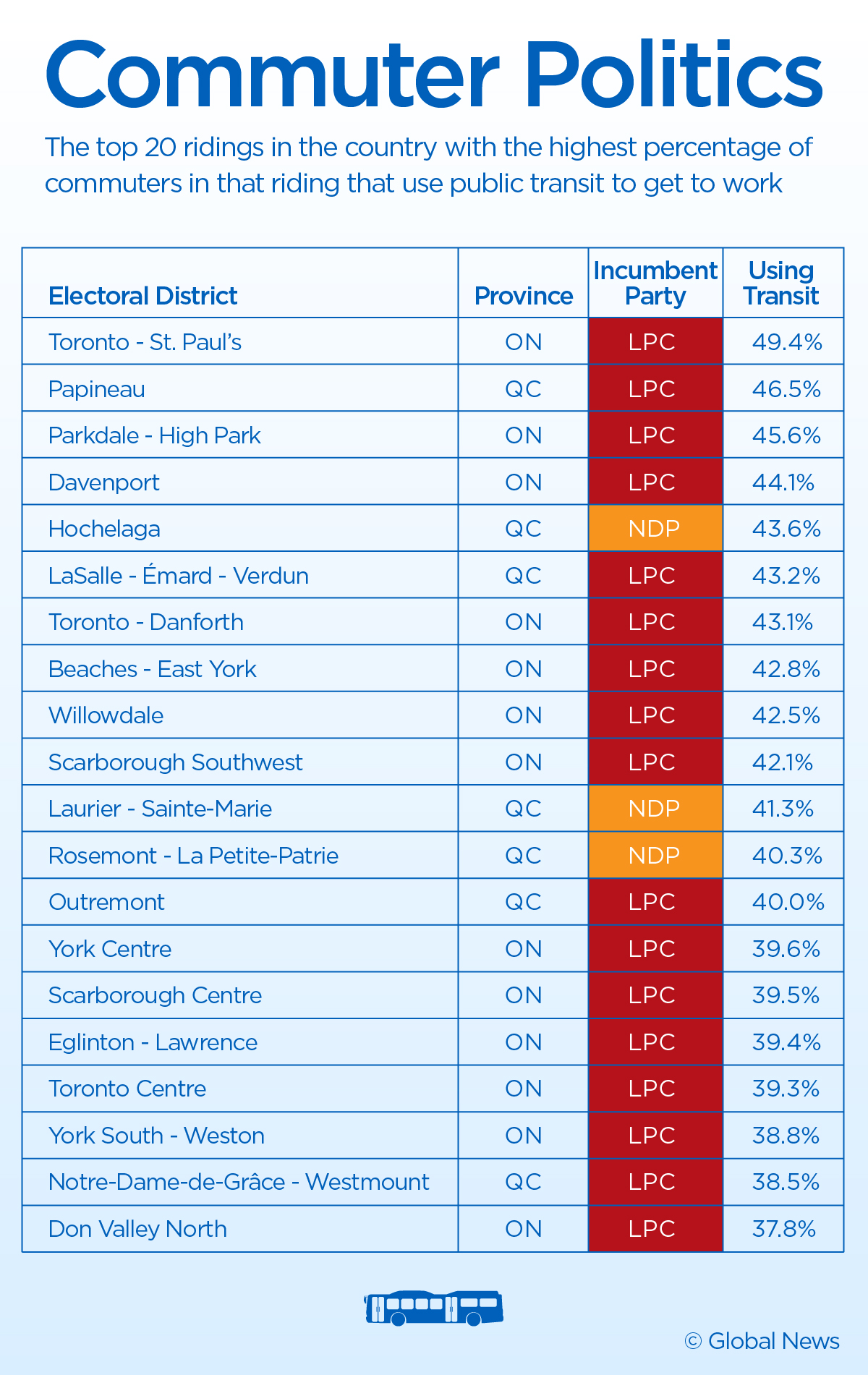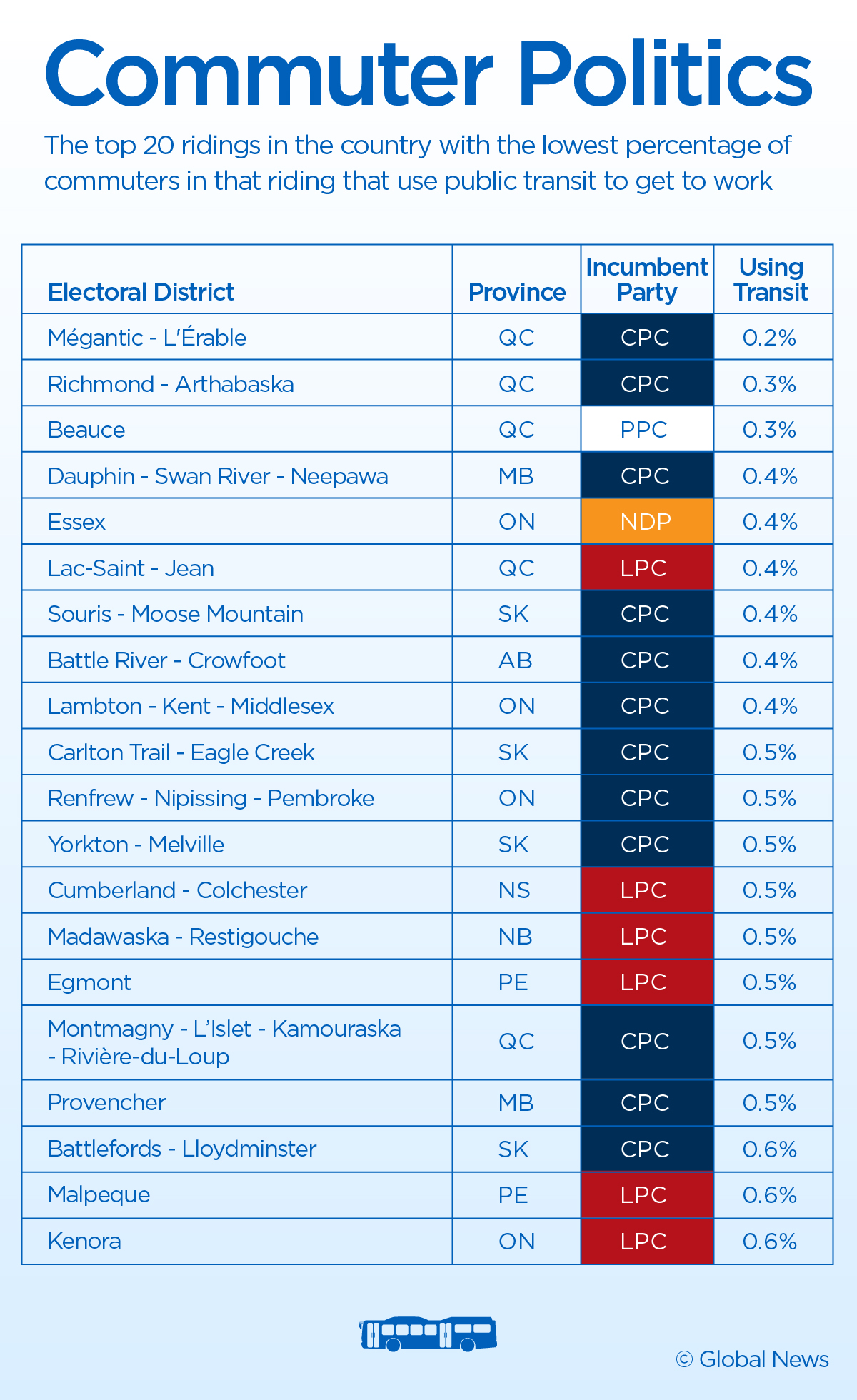Prime Minister Justin Trudeau was in his own riding in Montreal on Thursday to confirm that the federal government will spend $1.3 billion to extend a subway line.

For voters in Trudeau’s riding of Papineau who want their MP to bring home the bacon, it doesn’t get much bigger than this.
That’s because, among other things, Papineau has the highest percentage of commuters who use public transit to get to work of any riding in Montreal. Among Papineau’s 50,735 commuters, 46.5 per cent commute to work using public transit.
Subways and buses are a big deal to voters there.
WATCH: Trudeau announces $1.3 billion for Montreal Blue line extension

In fact, Papineau is No. 2 in the entire country when it comes to the percentage of commuters in the riding who use public transit. No. 1 is Toronto-St. Paul’s, held by Liberal Carolyn Bennett, where an astonishing 49.4 per cent use public transit to get to work.
Those numbers come from Statistics Canada, which has a lot of data on our commuting habits broken down not just by city or province but also by electoral district.
And those statistical slices help us put political debates into context when it comes to what I’ll call commuter politics, which could, particularly in the Greater Toronto Area, be a significant factor in this fall’s general election.
Commuters can make up a big chunk of the electorate in some ridings. The average across all ridings is 45 per cent, but there are some big variations.
Not surprisingly, there are more commuters in dense urban ridings and fewer in northern and rural ridings. The riding with the highest percentage of commuters is the downtown Toronto riding of Spadina-Fort York, held by Liberal Adam Vaughan. In Vaughan’s riding, 64 per cent of voters say they are commuters.
Few of Vaughan’s commuters, incidentally, use a car to get to work. Three-quarters of them either walk to work or take public transit.

Get breaking National news
WATCH: Boeing’s flying car looks to revolutionize commuter habits

Conversely, the northernmost ridings in both Saskatchewan and Manitoba — both of which are currently held by New Democrats — have the smallest percentage of citizens who call themselves commuters. In Desnethé-Missinippi-Churchill River, where Georgina Jolibois is the MP, just 27 per cent of residents commute to work, while to the east, in Churchill-Keewatinook Aski, where Niki Ashton is the MP, just 31 per cent are commuters.
Politicians designing policies that appeal to commuters would likely tailor them to two key variables: the method commuters use to get to work and the length of time it takes to commute.
Generally speaking, commuters in ridings currently held by Liberals tend to be higher users of public transit and have longer commute times than commuters in Conservative ridings, where the car is king and commute times are shorter.
This trend should not be a surprise to even the most casual observer of Canadian politics as voters in Canada’s largest urban centres tend to elect Liberals while voters in the country’s smaller cities and in rural areas tend to elect Conservatives. As urban cores tend to have easier access to more robust public transit systems, it would make sense that Liberal politicians, like Trudeau on Thursday, would pay more attention to transit.
In Conservative ridings, where the dominant method of commuting is the personal car, issues around carbon taxes and highway infrastructure could play a bigger role in voters’ minds.
In ridings currently held by Liberal MPs, an average of 15 per cent of commuters use public transit to get to work. In ridings held by Conservative MPs, just five per cent of commuters use public transit. In NDP ridings, the number is 11 per cent.
Three South Shore Quebec ridings that are side by side have the lowest transit use by the commuters. In Mégantic-L’Érable (Conservative), just 0.2 per cent of commuters use public transit; in Richmond-Arthabaska (Conservative) and the Beauce (People’s Party of Canada), it’s 0.3 per cent.
Meanwhile, ridings held by Conservatives are much more likely to have commuters who get to work in their own car, truck or van. Among the 96 Conservative ridings in the country, an average of 83 per cent of commuters use their own car. By contrast, in ridings held by Liberals or New Democrats, only about 71 per cent of commuters use their own car.
Ridings with lots of voters who have long commutes may be responsive to politicians selling plans to shorten those commute times. Indeed, we’ve seen this in Toronto municipal politics with the multi-year debates about extending a subway or light rapid transit time to Scarborough, where voters have ranked improved public transit as a top priority.
And, sure enough, if we go back to Statistics Canada’s data, we find the riding of Scarborough-Rouge River has the highest percentage of commuters of any riding in the country who say it takes them an hour or more to get to work. In that riding, which is currently represented by Liberal Gary Anandasangaree, 27 per cent of commuters need an hour or more to get to work. But it’s just about as bad in all five Scarborough ridings, where at least 20 per cent of commuters take an hour or more to get to work. That’s good enough to put all five Scarborough ridings in the top 20 ridings in the country for commuters who spend the most time getting to and from work.
WATCH: Federal government makes transit and carbon announcements

In fact, all 20 ridings with the highest percentage of commuters who take an hour or more to get to work are in the Greater Toronto Area or just border on the GTA.
At the other end of the scale, just 1.7 per cent of commuters in the Ontario ridings of Essex, south of Windsor, and in Sault Ste. Marie spend an hour or more getting to work. Those ridings are held, respectively, by New Democrat Tracey Ramsey and Liberal Terry Sheehan.
Essex, incidentally, has the single highest percentage of commuters who drive their own car, truck or van to work at 91 per cent.
In fact, the top ridings in the country when it comes to the percentage of commuters who use a car to get to work are mostly rural or ridings with a small city or two, like Jonquiere in Quebec (90 per cent), Malpeque in P.E.I. (90 per cent), Hastings-Lennox and Addington (89 per cent) in eastern Ontario or Fundy Royal (88 per cent) in New Brunswick.
David Akin covers Canadian federal and electoral politics and is currently chief political correspondent for Global News.





Comments